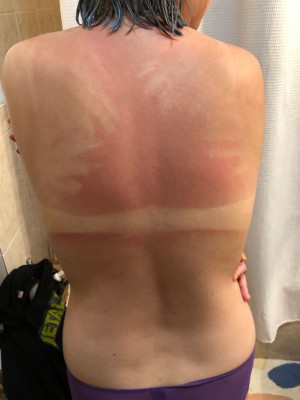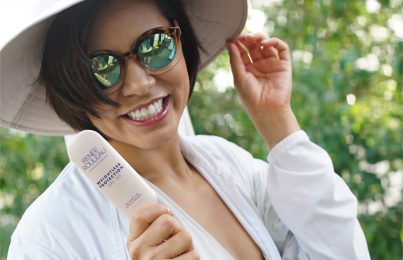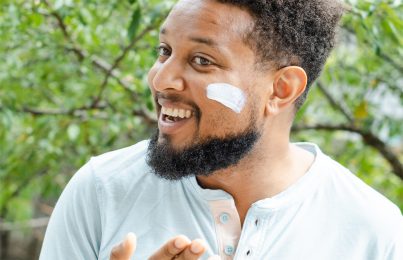Updated 06/22/22. Make no mistake—sunscreen is critical for preserving skin health. You should wear it every single day, rain or shine, to protect your skin from harmful UV rays. However, it shouldn’t be your only line of defense against sun damage. People think, “If I wear sunscreen I can be out in the sun as much as I want to and I’ll be protected.” I’m here to tell you that this simply isn’t the case, and acting like it is will put you at risk for premature photo-aging, or worse, skin cancer. I’m telling you this not only as an esthetician with 30 years of experience but also as someone who has had her own skin cancer scare. Trust me when I say that sun protection is everything!
In order to effectively protect yourself against harmful UV rays, you need to look at the bigger picture when it comes to sun protection. Keep scrolling to see three things that (along with consistent sunscreen application) will keep you protected.
1. Wear Sun-Protective Clothing

Wearing any type of clothing that covers your skin is a step in the right direction. However, if you’ll be spending a lot of time outdoors, whether you’re hiking, biking, or spending a day at the beach, take it a step further by wearing clothes that have a UPF rating. UPF stands for Ultraviolet Protection Factor. It’s a measurement of sun protection in clothing, and it means it has gone through rigorous testing with light exposure to make sure it’s providing adequate protection.
This is better than regular clothing, which allows UV light to be transmitted through the weaves of the fabric—especially through natural fibers and lighter-colored fabrics. These tend to transmit more UV light than synthetic fibers and darker-colored fabrics.
UPF ratings typically range anywhere from 15 to 50. The higher the rating, the better the sun protection. The white hat and shirt I’m wearing in the picture above are both UPF rated! Some of my favorite sun-protective clothing brands are Cover and Solumbra by Sun Protections. (Many sun-protective clothing companies list the number of washes that a garment will retain its UPF rating for. Check this to ensure your UPF clothing is retaining its UPF value. As with any other type of clothing, the sun-protective kind can wear down over time.)
I’ve always preferred using sun-protective clothing as my first line of defense when I know I’ll be spending a lot of time outdoors. It’s so much easier than constantly reapplying sunscreen. Plus, you don’t have to worry about uneven application leaving parts of your skin vulnerable. If you don’t want to buy sun-protective clothing, you can make your own by using Rit Sunguard. It’s a treatment that goes right in with your laundry and washes UV protection into your clothes. Each treatment provides a UPF rating of 30 to your clothing, and it lasts for up to 20 washes! This is a tip I learned from dermatologist Dr. Kavita Mariwalla during my Ask an Expert Instagram Live series.
Using Rit Sunguard is an easy way to add sun protection to everyday clothing, but it’s not necessary for denim. Dr. Mariwalla says that denim offers the best sun protection of any fabric, simply because it’s so tightly woven.
2. Wear Hats and Sunglasses
Hats and sunglasses are an extension of sun-protective clothing, yet they’re important to mention nonetheless. When it comes to hats, be sure to pick one with a wide brim that goes all the way around your head and extends out far enough to give you good coverage. You can also get a hat with a UPF rating to protect the delicate skin on your face and neck. A good brand for UPF-rated sun hats is Wallaroo.
When it comes to sunglasses, be sure to pick a pair that covers the entire orbital area. This is important since this area is the first to show signs of aging. It’s also susceptible to skin cancer because the skin is so thin. Not only will a good pair of sunglasses keep your skin protected, but they will keep you from squinting in bright light, which can prevent fine lines and wrinkles from forming.
Speaking of sneaky ways the sun could be damaging your skin, your hands are also at risk for sun damage. Most people rarely think about how much sun exposure their hands get, especially while they’re out and about, driving, and running errands. This intermittent sun exposure adds up over time, which is why it’s important to nip it in the bud by applying sunscreen to your hands. You can even invest in a pair of UPF-rated driving gloves, like those from Coolibar.
3. Avoid Peak Sun Hours
Finally, one of the easiest ways to protect yourself against damaging sun exposure is to avoid peak sun hours. Peak sun hours can be different depending on where you live, but the general rule is from 10 am to 4 pm. This doesn’t mean you shouldn’t go outside at all, it just means you should avoid prolonged, direct exposure.
Another tip I learned from Dr. Mariwalla is to check the UV index on your phone before heading outside. You can conveniently find it right in the weather app on an iPhone. If you don’t have an iPhone, you can also find it on the Environmental Protection Agency’s website. The UV index indicates the level of UV radiation in a specific geographical area at a specific time. It’s measured on a scale of 0 to 11+, with 0-2 meaning low UV radiation, 3-7 meaning moderate UV radiation, and 8+ meaning high to extreme UV radiation. Depending on the UV index, you can tell how diligent you need to be about sun protection.
Seeking Shade Isn’t Enough
There’s one more thing I want to mention. A lot of people might rely on an umbrella for sun protection during a day at the beach, but here’s the thing—shade does NOT equal sunscreen. You’re still being exposed to UV rays that cause premature skin aging and skin cancer. That’s why sunscreen and sun-protective clothing are still necessary. For example, in the picture above, I’m wearing a UPF shirt and sunscreen, despite sitting under an umbrella.
There you have it. Doing these three things in conjunction with wearing sunscreen will ensure you’re protected from UV rays!
Next, read up on five skincare mistakes that could be making your sunscreen less effective.
Celebrity Esthetician & Skincare Expert
As an esthetician trained in cosmetic chemistry, Renée Rouleau has spent 30 years researching skin, educating her audience, and building an award-winning line of products. Her hands-on experience as an esthetician and trusted skin care expert has created a real-world solution — products that are formulated for nine different types of skin so your face will get exactly what it needs to look and feel its best. Trusted by celebrities, editors, bloggers, and skincare obsessives around the globe, her vast real-world knowledge and constant research are why Marie Claire calls her “the most passionate skin practitioner we know.”



